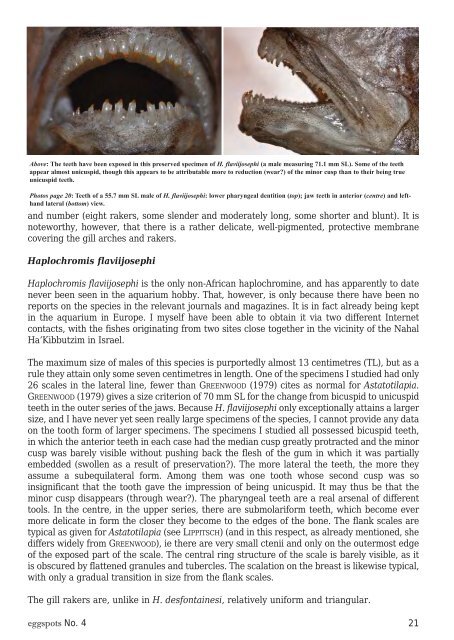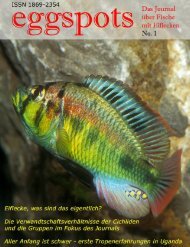Eggspots Elsewhere - Welt der Fische / World of Fishes
Eggspots Elsewhere - Welt der Fische / World of Fishes
Eggspots Elsewhere - Welt der Fische / World of Fishes
You also want an ePaper? Increase the reach of your titles
YUMPU automatically turns print PDFs into web optimized ePapers that Google loves.
Above: The teeth have been exposed in this preserved specimen <strong>of</strong> H. flaviijosephi (a male measuring 71.1 mm SL). Some <strong>of</strong> the teeth<br />
appear almost unicuspid, though this appears to be attributable more to reduction (wear?) <strong>of</strong> the minor cusp than to their being true<br />
unicuspid teeth.<br />
Photos page 20: Teeth <strong>of</strong> a 55.7 mm SL male <strong>of</strong> H. flaviijosephi: lower pharyngeal dentition (top); jaw teeth in anterior (centre) and lefthand<br />
lateral (bottom) view.<br />
and number (eight rakers, some slen<strong>der</strong> and mo<strong>der</strong>ately long, some shorter and blunt). It is<br />
noteworthy, however, that there is a rather delicate, well-pigmented, protective membrane<br />
covering the gill arches and rakers.<br />
Haplochromis flaviijosephi<br />
Haplochromis flaviijosephi is the only non-African haplochromine, and has apparently to date<br />
never been seen in the aquarium hobby. That, however, is only because there have been no<br />
reports on the species in the relevant journals and magazines. It is in fact already being kept<br />
in the aquarium in Europe. I myself have been able to obtain it via two different Internet<br />
contacts, with the fishes originating from two sites close together in the vicinity <strong>of</strong> the Nahal<br />
Ha’Kibbutzim in Israel.<br />
The maximum size <strong>of</strong> males <strong>of</strong> this species is purportedly almost 13 centimetres (TL), but as a<br />
rule they attain only some seven centimetres in length. One <strong>of</strong> the specimens I studied had only<br />
26 scales in the lateral line, fewer than GREENWOOD (1979) cites as normal for Astatotilapia.<br />
GREENWOOD (1979) gives a size criterion <strong>of</strong> 70 mm SL for the change from bicuspid to unicuspid<br />
teeth in the outer series <strong>of</strong> the jaws. Because H. flaviijosephi only exceptionally attains a larger<br />
size, and I have never yet seen really large specimens <strong>of</strong> the species, I cannot provide any data<br />
on the tooth form <strong>of</strong> larger specimens. The specimens I studied all possessed bicuspid teeth,<br />
in which the anterior teeth in each case had the median cusp greatly protracted and the minor<br />
cusp was barely visible without pushing back the flesh <strong>of</strong> the gum in which it was partially<br />
embedded (swollen as a result <strong>of</strong> preservation?). The more lateral the teeth, the more they<br />
assume a subequilateral form. Among them was one tooth whose second cusp was so<br />
insignificant that the tooth gave the impression <strong>of</strong> being unicuspid. It may thus be that the<br />
minor cusp disappears (through wear?). The pharyngeal teeth are a real arsenal <strong>of</strong> different<br />
tools. In the centre, in the upper series, there are submolariform teeth, which become ever<br />
more delicate in form the closer they become to the edges <strong>of</strong> the bone. The flank scales are<br />
typical as given for Astatotilapia (see LIPPITSCH) (and in this respect, as already mentioned, she<br />
differs widely from GREENWOOD), ie there are very small ctenii and only on the outermost edge<br />
<strong>of</strong> the exposed part <strong>of</strong> the scale. The central ring structure <strong>of</strong> the scale is barely visible, as it<br />
is obscured by flattened granules and tubercles. The scalation on the breast is likewise typical,<br />
with only a gradual transition in size from the flank scales.<br />
The gill rakers are, unlike in H. desfontainesi, relatively uniform and triangular.<br />
eggspots No. 4<br />
21




